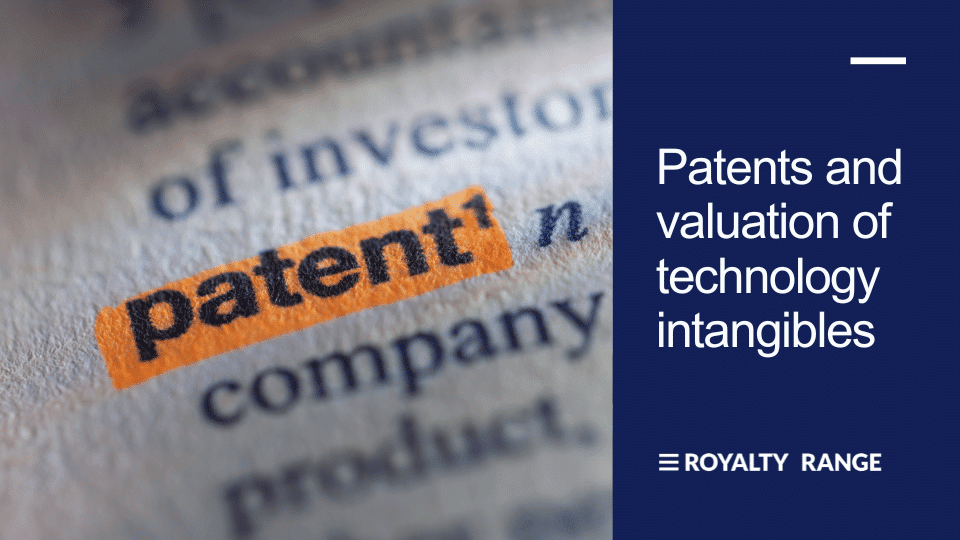Patents and valuation of technology intangibles
November 15, 2023

Patents play a significant role in valuing technology intangibles. They provide legal protection for innovations, influencing the valuation of technology assets. The value of a patent depends on various factors:
- Uniqueness of Innovation: The novelty and uniqueness of the technology compared to existing solutions greatly impact its value.
- Market Demand: The potential market size and demand for the patented technology influence its value. A patent for a product or process in high demand would typically have a higher valuation.
- Competitive Advantage: Patents can confer a competitive advantage by preventing others from using the same technology, thereby increasing the valuation.
- Remaining Lifespan: The remaining duration of the patient’s life affects its value. Patents closer to expiration might have lower valuations.
- Commercial Viability: The potential to generate revenue or create cost savings based on the patented technology contributes to its valuation.
Valuing technology intangibles often involves complex methodologies, considering the above factors along with market trends, industry standards, and the specific circumstances surrounding the technology’s development and potential.
Patent valuation can be performed using three main approaches:
- Market Approach
- Income Approach
- Cost Approach
Market Approach
The Market Approach relies on comparisons with similar patents that have been sold or licensed in the marketplace. This approach assesses the value of a patent by examining the prices paid for similar patents in recent transactions.
Here’s how the Market Approach typically works for patent valuation:
- Comparable Analysis: It involves identifying patents that are similar in terms of technology, industry, market potential, and other relevant factors. These comparable patents serve as benchmarks for determining the value.
- Transaction Data: Information on actual transactions involving similar patents (sales, licenses, etc.) is gathered. This data includes the sale price, license fees, royalties, or any other financial terms associated with the transactions.
- Adjustments: Adjustments are made to account for differences between the subject patent and the comparable patents. Factors such as technological advancements, market size, patent scope, remaining lifespan, and competitive landscape are considered for these adjustments.
- Valuation: Based on the analysis of comparable transactions and the adjustments made, an estimated value for the subject patent is derived.
However, it’s crucial to note that finding truly comparable patents can be challenging due to the uniqueness of each patent.
Income Approach
The Income Approach focuses on estimating the value of a patent based on the income it can generate over its remaining lifespan. This approach evaluates the future economic benefits derived from the patent and discounts them to their present value.
Here’s how the Income approach typically works for patent valuation:
- Income Projections: Future income or cash flows expected from the use of the patent are forecasted. This includes revenue generated from sales or licensing fees, cost savings, or any other economic benefits attributable to the patent.
- Discounting Cash Flows: The projected income is discounted to its present value using a discount rate. This rate accounts for factors such as the time value of money, risk associated with the patent, and opportunity costs.
- Risk Assessment: Risks specific to the patent, industry, market competition, and technology advancements are considered in determining the discount rate. Higher risks associated with the patent may lead to a higher discount rate and consequently a lower valuation.
- Terminal Value: For patents with extended lifespans or perpetual income, a terminal value is often estimated to capture the ongoing benefits beyond the explicit projection period. This terminal value is also discounted back to the present.
- Valuation: The present value of the projected income stream and terminal value, after discounting, provides an estimate of the patent’s value using the Income approach.
This approach considers the expected future financial gains directly attributable to the patent. It’s especially useful for patents with clear revenue-generating potential, such as those used in commercial products, processes with cost-saving applications, or patents with licensing potential.
However, the Income Approach requires accurate and reliable projections of future income, which can be challenging, especially for emerging technologies or patents with uncertain market adoption. Expertise in financial analysis, market research, and understanding of the technology landscape is crucial for a robust valuation using the Income approach.
Cost Approach
The Cost Approach focuses on determining the value of a patent based on the costs incurred to develop or recreate the patented technology. This approach values the patent by assessing the expenses invested in its creation, development, and implementation, rather than relying on income or market comparisons.
Here’s how the Cost Approach typically works in patent valuation:
- Cost Estimation: This involves calculating the historical costs incurred in developing the patented technology. It includes expenses related to research, development, testing, legal fees for obtaining the patent, and any other direct costs associated with creating the patent.
- Adjustments: Adjustments are made to the historical costs to reflect the current value of the technology. Factors like technological advancements, obsolescence, changes in market conditions, and the patent’s remaining useful life are considered in these adjustments.
- Replacement Cost: Another aspect of the Cost Approach is estimating the cost to recreate or replace the patented technology at current market rates. This considers the expenses that would be required to develop a similar technology from scratch in the present environment.
- Depreciation: The depreciated value of the patent is calculated based on its remaining useful life. The value of the patent decreases over time due to factors like technological advancements or changes in market demand.
- Valuation: The final value of the patent using the Cost Approach is determined by considering the adjusted historical costs, replacement cost, and any depreciation.
The Cost Approach is useful when there’s limited or no reliable income data available for the patent, or when the patent’s technology isn’t actively commercialized. It provides a baseline value grounded in the actual costs incurred in developing the technology.
However, this approach may not account for the full market or income potential of the patent, especially if the technology has significant untapped market value or potential beyond its development costs. Expertise in financial analysis, understanding of the industry, and knowledge of patent development processes is essential for a thorough valuation using the Cost Approach.
Importance of data
Data is crucial for patent valuation as it forms the foundation for assessing the value of a patent accurately. Without accurate data, the valuation process becomes more speculative and less grounded in reality. Accurate valuation requires a comprehensive understanding of the patient’s competitive landscape, market potential, financial implications, and risks involved, all of which are informed by data.
Valuation of technology intangibles involves determining the monetary worth of intangible assets related to technology, such as patents, trademarks, trade secrets, software, copyrights, and proprietary knowledge, among others. These assets are valuable components of a company’s intellectual property (IP) and can significantly contribute to its competitive advantage and overall value.
RoyaltyRange offers the possibility to save time and get reliable data for your valuation. High-quality data complies with the requirements of OECD BEPS. Agreements are manually analyzed for more than 50 comparability factors, with detailed functional, risk, cost, and asset analyses. You will get fully analyzed, clean, and structured data for each agreement.
Check possibilities of RoyaltyRange Royalty Rates database here. Ask for trial version or live demo here.
The information provided below is for general informational purposes only and should not be construed as legal or tax advice. It is not a substitute for consulting with a qualified legal or tax professional.
Sources:
Request One Search
We will perform the search and deliver the initial results within hours, at no cost.




